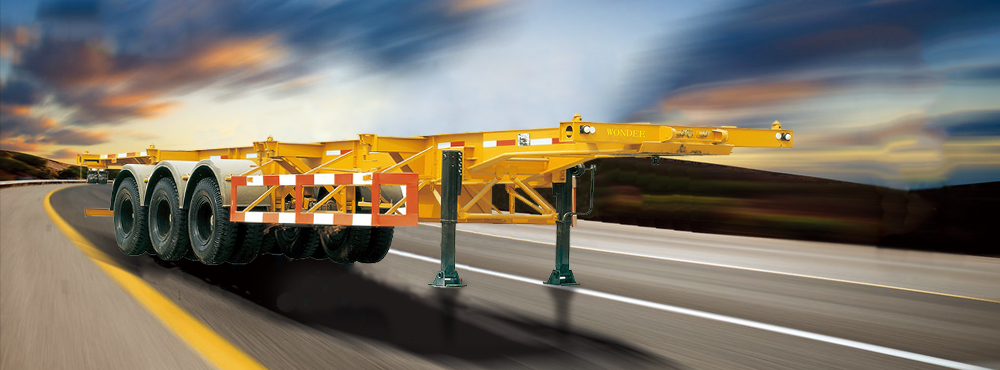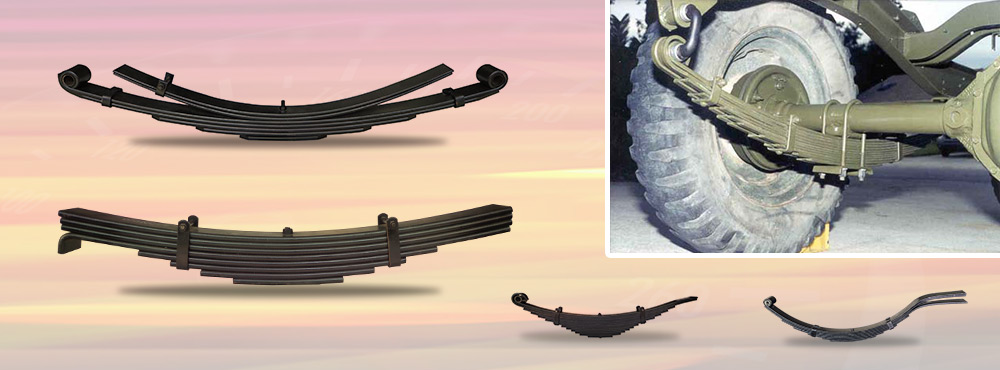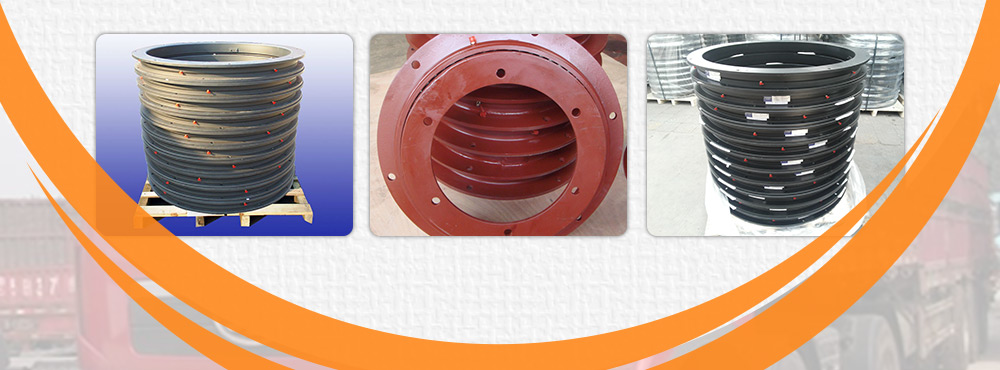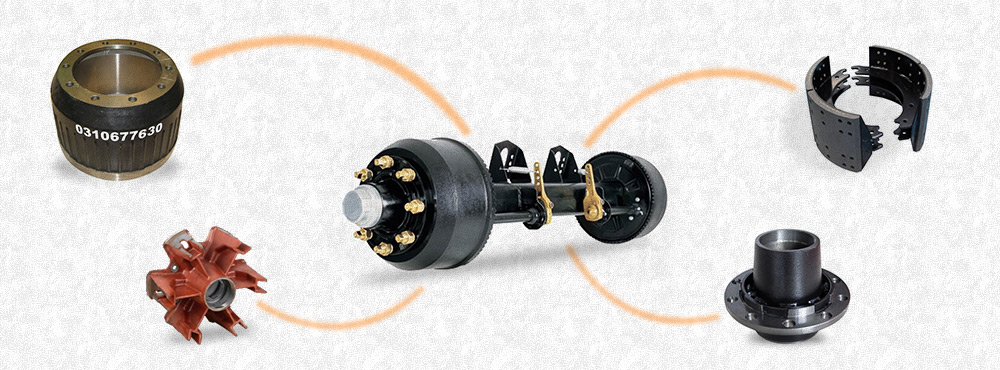CATEGORIES
SEMI TRAILER
Your Position:Home>>Semi Trailer
tire manufacture
2016-03-11 10:04:02
Tire manufacturing Pneumatic tires are manufactured according to relatively standardized processes and machinery, in around 450 tire factories in the world. With over 1 billion tires manufact ured worldwide annually, the tire industry is the major consumer of natural rubber. Tire factories start with bulk raw materials such as rubber, carbon black (炭黑), and chemicals and produce numerous specialized components that are assembled and cured(加硫). This article describes the components assembled to make a tire, the various materials used, the manufacturing processes and machinery, and the overall business model. The tire is an assembly of numerous components that are built up on a drum(指轮 胎成型鼓) and then cured in a press under heat and pressure. Heat facilitates a polymerization reaction 聚合反应) that crosslinks rubber monomers 单体) to create ( ( long elastic(弹性的) molecules. These polymers create the elastic quality that permits the tire to be compressed in the area where the tire contacts the road surface and spring back to its original shape under high-frequency cycles. Typical components used in tire assembly are listed below. Inner liner The inner liner is an extruded(挤出,伸出) halobutyl rubber sheet compounded with additives that result in low air permeability. The inner liner assures that the tire will hold high-pressure air inside, without the air gradually diffusing through the rubber structure. Body ply The body ply is a calendered(压延) sheet consisting of one layer of rubber, one layer of reinforcing fabric, and a second layer of rubber. The earliest textile used was cotton; later materials include rayon(人造纤维), nylon, polyester(涤纶, 聚酯纤维), and Kevlar(凯芙拉,一种合成纤维). Passenger tires typically have one or two body plies. Body plies give the tire structure strength. Truck tires, off-road tires, and aircraft tires have progressively more plies. The fabric cords are highly flexible but relatively inelastic. Sidewall(轮胎壁) Sidewall(轮胎壁) Sidewalls are non-reinforced extruded profiles(侧面) with additives to give the sides of the tire good abrasion resistance and environmental resistance. Additives used in sidewall compounds include antioxidants(抗氧化剂) and antiozonants(防 臭氧剂). Sidewall extrusions(挤出,挤压) are nonsymmetrical and provide a thick rubber area to enable molding of raised letters and sidewall ornamentation.
Beads(胎圈)
Beads are bands of high tensile(拉伸,延展)-strength steel wire encased in a rubber compound. Bead wire is coated with special alloys (合金) of bronze or brass. Coatings protect the steel from corrosion(腐蚀). Copper in the alloy and sulfur in the rubber cross-link(交叉结合) to produce copper sulfide(硫化物), which improves bonding of the bead to the rubber. Beads are inflexible and inelastic, and provide the mechanical strength to fit the tire to the wheel. Bead rubber includes additives to maximize strength and toughness. Apex(三角胶) Apex(三角胶) The apex is a triangular extruded profile that mates(是紧密结合) against the bead. The apex provides a cushion between the rigid bead and the flexible inner liner (衬里) and body ply assembly. Alternatively called "filler" (as in the diagram above). Belt package Belts are calendared sheets consisting of a layer of rubber, a layer of closely spaced steel cords, and a second layer of rubber. The steel cords are oriented radially (放射状地) in radial tire construction, and at opposing angles in bias tire construction. Belts give the tire strength and dent resistance while allowing it to remain flexible. Passenger tires are usually made with two or three belts. Tread The tread is a thick extruded profile that surrounds the tire carcass. Tread compounds include additives to impart wear resistance and traction in addition to environmental resistance. Tread compound development is an exercise in compromise, as hard compounds have long wear characteristics but poor traction whereas soft compounds have good traction but poor wear characteristics. Cushion gum Many higher-performing tires include an extruded component between the belt package and the tread to isolate the tread from mechanical wear from the steel belts. Other components Tire construction methods vary somewhat in the number and type of components, as well as the compound formulations for each component, according to the tire use and price point. Tire makers continuously introduce new materials and construction methods in order to achieve higher performance at lower cost.
Materials
Natural rubber, or polyisoprene(聚异戊二烯) is the basic elastomer(合 成橡胶) used in tire making Styrene-butadiene co-polymer (SBR,合成橡胶) is a synthetic rubber which is often substituted in part for natural rubber based on the comparative raw materials cost Polybutadiene(聚丁二烯) is used in combination with other rubbers because of its low heat-buildup(增强) properties(属性) Halobutyl rubber is used for the tubeless inner liner compounds, because of its low air permeability(渗透性). The halogen(卤族元素) atoms provide a bond with the carcass compounds which are mainly natural rubber. Bromobutyl (溴化丁基橡胶) is superior to chlorobutyl(氯化丁基橡胶), but is more expensive Carbon Black forms a high percentage of the rubber compound. This gives reinforcement and abrasion resistance Silica (二氧化硅) used together with carbon black in high performance tires, , as a low heat build up reinforcement Sulphur crosslinks the rubber molecules in the vulcanization process Vulcanizing Accelerators are complex organic compounds that speed up the vulcanization Activators(催化剂) assist the vulcanization. The main one is zinc oxide (氧化锌) Antioxidants and antiozonants prevent sidewall cracking due to the action of sunlight and ozone Textile fabric reinforces the carcass of the tire
Manufacturing process Tire plants are traditionally divided into five departments that perform special operations. These usually act as independent factories within a factory. Large tire makers may set up independent factories on a single site, or cluster the factories locally across a region. Compounding Compounding and mixing Compounding is the operation of bringing together all the ingredients required to mix a batch of rubber compound. Each component has a different mix of ingredients according to the properties required for that component. Mixing is the process of applying mechanical work to the ingredients in order to blend them into a homogeneous substance. Internal mixers (搅拌器) are often equipped with two counter-rotating rotors(旋转轮) in a large housing that shear(cut) the rubber charge(填充物) along with the additives. The mixing is done in three or four stages to incorporate the ingredients in the desired order. The shearing action generates considerable heat, so both rotors and housing are water-cooled(水冷式的) to maintain a temperature low enough to assure that vulcanization does not begin. After mixing, the rubber charge is dropped into a chute and fed by an extruding screw into a roller die(模具). Alternatively, the batch(一批生产量) can be dropped onto an open rubber mill batchoff system. A mill consists of twin counter-rotating rolls, one serrated(锯齿状的), that provide additional mechanical working to the rubber and produce a thick rubber sheet. The sheet is pulled off the rollers in the form of a strip. The strip is cooled, dusted with talc(滑石,云母), and laid down into a pallet(托盘,车架接头) bin. The ideal compound at this point would have a highly uniform material dispersion; however in practice there is considerable non-uniformity to the dispersion. This is due to several causes, including hot and cold spots in the mixer housing and rotors, excessive rotor clearance, rotor wear(磨损), and poorly circulating flow paths. As a result, there can be a little more carbon black here, and a little less there, along with a few clumps(团) of carbon black elsewhere, that are not well mixed with the rubber or the additives. Mixers are often controlled according to the power integration method, where the current flow to the mixer motor is measured, and the mixing terminated upon reaching a specified total amount of mix energy imparted to the batch. Component preparation Components fall into three classes based on manufacturing process: calendaring, extrusion, and bead building. The extruder(挤出机) machine consists of a screw(旋转器) and barrel, screw (螺旋状) drive(传动装置), heaters, and a die(模具). The extruder applies two conditions to the compound: heat and pressure. The extruder screw also provides for additional mixing of the compound through the shearing action of the screw. The compound is pushed through a die, after which the extruded profile is vulcanized in a continuous oven, cooled to terminate the vulcanization process, and either rolled up on a spool(线轴) or cut to length. Tire treads are often extruded with four components in a quadruplet extruder, one with four screws processing four different compounds, usually a base compound, core compound, tread compound, and wing compound. Extrusion is also used for sidewall profiles and inner liners. The calender is a set of multiple large-diameter rolls that squeeze rubber compound into a thin sheet, usually of the order of 2 meters wide. Fabric calendars produce an upper and lower rubber sheet with a layer of fabric in between. Steel calendars do so with steel cords. Calendars are used to produce body plies and belts. A creel room is a facility that houses hundreds of fabric or wire spools that are fed into the calendar. Calendars utilize downstream equipment for shearing and splicing (接头) calendared components. Tire building Tire building is the process of assembling all the components onto a tire building drum. Tire-building machines (TBM,轮胎成型机) can be manually operated or fully automatic. Typical TBM operations include the first-stage operation, where inner liner, body plies, and sidewalls are wrapped around the drum, the beads are placed, and the assembly turned up over the bead. In the second stage operation the belt package and tread are applied and the green(new) tire is inflated and shaped. All components require splicing. Inner liner and body plies are spliced with a square-ended overlap(重叠). Tread and sidewall are joined with a skived(削均 匀的) splice, where the joining ends are bevel(斜面,斜角)-cut. Belts are spliced end to end with no overlap. Splices that are too heavy or non-symmetrical will generate defects in force variation, balance, or bulge parameters. Splices that are too light or open can lead to visual defects and in some cases tire failure. The final product of the TBM process is called a green tire, where green refers to the uncured(未加硫) state. Pirelli(意大利轮胎,倍耐力) Tire developed a special process called MIRS(轮胎 模块化集成自动生产系统 (Modular Integrated Robotized System, 缩写 MIRS) that uses ) robots to position and rotate the building drums under stations that apply the various components, usually via extrusion and strip winding methods. This permits the equipment to build different tire sizes in consecutive operations without the need to change tooling or setups. This process is well suited to small volume production with frequent size changes. The largest tire makers have internally developed automated tire-assembly machines in an effort to create competitive advantages in tire construction precision, high production yield, and reduced labor. Nevertheless there is a large base of machine builders(生成器) who produce tire-building machines. Curing Curing is the process of applying pressure to the green tire in a mold in order to give it its final shape, and applying heat energy to stimulate the chemical reaction between the rubber and other materials. In this process the green tire is automatically transferred onto the lower mold bead seat, a rubber bladder is inserted into the green tire, and the mold closes while the bladder(气囊) inflates. As the mold closes and is locked the bladder pressure increases so as to make the green tire flow into the mold, taking on the tread pattern and sidewall lettering engraved into the mold. The bladder is filled with a recirculating(再循环的,回路的) heat transfer medium, such as steam, hot water, or inert gas. Temperatures are in the area of 350 degrees Fahrenheit with pressures around 350 PSI(每平方寸上的压力磅 数). Passenger tires cure in approximately 15 minutes. At the end of cure the pressure is bled down, the mold opened, and the tire stripped out of the mold. The tire may be placed on a PCI, or post-cure inflator, that will hold the tire fully inflated while it cools. There are two generic(general) curing press types, mechanical and hydraulic(水力的,液压的). Mechanical presses hold the mold closed via toggle (触发器) linkages(连接,连接装置), while hydraulic presses use hydraulic oil as the prime mover(推进器) for machine motion, and lock the mold with a breech (后膛)-lock mechanism. Hydraulic presses have emerged as the most cost-effective because the press structure does not have to withstand the mold-opening pressure and can therefore be relatively lightweight. There are two generic mold types, two-piece molds and segmental molds. Large off-road tires are often cured in ovens with cure times approaching 24 hours. Final finish After the tire has been cured, there are several additional operations. Tire uniformity measurement is a test where the tire is automatically mounted on wheel halves, inflated, run against a simulated road surface, and measured for force variation. Tire balance measurement is a test where the tire is automatically placed on wheel halves, rotated at a high speed and measured for imbalance. Large commercial truck/bus tires, as well as some passenger and light truck tires, are inspected by X-ray machines that can penetrate the rubber to analyze the steel cord structure. In the final step, tires are inspected by human eyes for numerous visual defects such as incomplete mold fill, exposed cords, blisters((内外轮胎内部)气泡), blemishes, and others.
Related reading: Wheel rim Semi trailer
Previous:North American Trucks
Next:Semi Trailer













